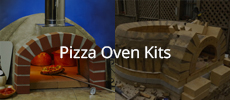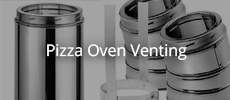Originally posted by narcosi
View Post
Announcement
Collapse
No announcement yet.
Oven Narcosi - Tunnel Oven Build - UK
Collapse
X
-
Sorry, I was forgetting you’re doing a barrel arch. They can be brick or cast. If you cast or brick, be sure to place wedges under the former so when they’re removed it will drop and you can slide it out. Wedges at the back of the former may need to have rope attachments because they’re hard to access. As you are in UK the uk wood fired oven forum may be of some use.
- Likes 1
-
Some use ceramic rope or 5:1 vermicrete or ceramic fibre blanket or air. The gap on my design is between the outer arch and the flue gallery because the flue gallery is only 10 kg cast refractory and it’s insulated so is not much of a heat sink. I fill the gap between the floor and arch with ceramic fibre blanket sealed at the top with 5:1 vermicrete. At the top of the arch is just 5:1 vermicrete and I leave the sides as just an air gap.Originally posted by narcosi View Post
Thanks - if you leave a gap - what would you recommend filling it with?
Search for “thermal break” to see what others have done, or someone else may chime in with other ideas.Last edited by david s; 05-04-2020, 01:00 PM.
- Likes 2
Leave a comment:
-
Thanks David really appreciate your input - 2 more questions knocked offOriginally posted by david s View Post
11. Standard house bricks should be fine, as the outer arch doesn’t get really hot.
14. If you want, but they invariably fail eventually. Most folk don’t rely on them after using their oven lots. Their placement will give you different readings depending on where you place them. There are many ways to gauge the temperature without the use of thermocouples.
Leave a comment:
-
Thanks - if you leave a gap - what would you recommend filling it with?Originally posted by david s View Post4. It is important to insulate both under and over the oven to prevent heat loss. As the flue gallery and outer arch are connected to the oven, they can act as a heat sink drawing heat out of the inner oven chamber. An expansion gap reduces heat flow by conduction as well as reducing pressure on the cooler outer oven parts thereby reducing propensity to cracking. Some builders do add an expansion joint/heat break, some don’t.
Leave a comment:
-
4. It is important to insulate both under and over the oven to prevent heat loss. As the flue gallery and outer arch are connected to the oven, they can act as a heat sink drawing heat out of the inner oven chamber. An expansion gap reduces heat flow by conduction as well as reducing pressure on the cooler outer oven parts thereby reducing propensity to cracking. Some builders do add an expansion joint/heat break, some don’t.
9. The outer arch can be either cast or laid with brick
11. Standard house bricks should be fine, as the outer arch doesn’t get really hot.
14. If you want, but they invariably fail eventually. Most folk don’t rely on them after using their oven lots. Their placement will give you different readings depending on where you place them. There are many ways to gauge the temperature without the use of thermocouples.
- Likes 1
Leave a comment:
-
Bump! would really like everyone's advice on some specifics. thanks
Leave a comment:
-
Hi all - making good progress with your help and other threads - i am updating my first post with answers for future builders
here are the most prominent remaining questions thanks:
4) I have seen people insulate between the oven and the front arch and even before the flu? why? should I?
9) what do you think about the precast arches? is it worth me making my own from brick rather than using these?
11) I have standard domestic clay bricks which you can see in the photo - i want to make the front arch from these? will that be ok? linked to question 4 - should i insulate them from the oven?
14) should i install thermocouples? if so where?
Leave a comment:
-
Thanks, yeah dimney height will be interesting to set - i would like stainless (looks wise)Originally posted by mirassou View PostIf memory serves me, I believe that the standard floor height is somewhere 40" If the oven is going to be below standard height, the flue will need to be that much higher in order to ensure that fumes and heat are well above your head.
Insulation below the concrete base is useless. Your ceramic fiber board will insulate the base of the oven and that will go on top of the concrete base.
I don't see where dimensions will prevent you from doing a dome. You could just make it smaller if necessary.
I had assumed it was pointless but i thought i would see if anyone though it was worth it as it was free.
As for the dome or even an oval, i think i am set on barrel now....roasting and bread is as much if not more of the value for me as pizza. Also wife prefers the look
Leave a comment:
-
If memory serves me, I believe that the standard floor height is somewhere 40" If the oven is going to be below standard height, the flue will need to be that much higher in order to ensure that fumes and heat are well above your head.
Insulation below the concrete base is useless. Your ceramic fiber board will insulate the base of the oven and that will go on top of the concrete base.
I don't see where dimensions will prevent you from doing a dome. You could just make it smaller if necessary.
- Likes 1
Leave a comment:
-
thanks for the pointer really good readOriginally posted by UtahBeehiver View PostSince you decided to do a barrel or tunnel oven. You should look at Tscar's build, done very nicely. Play close attention to the buttressing he did and how he placed the end walls.
https://community.fornobravo.com/for...71-it-is-begun
Leave a comment:
-
- Likes 1
Leave a comment:
-
thanks again -Originally posted by deejayoh View PostDistance from the tree is subject to local regulations, but I know here in Seattle, an outdoor fireplace (applicable category) should be no closer than 15 feet of a structure or combustible material or vegetation. So a long chimney is good - but not if its poking through a tree. Gases coming out of the flue are hot enough to combust wood!
That said, I understand limitations! What is the substructure on the patio? hoping it is poured concrete
yes some things i have full control of and the patio is strong enough and weirdly i have hidden rebar under the flower bed to tie the concrete base into......
What do you think of putting extra insulation under the concrete - is there any point? i have some old poly and also some old celotex....also have to decide on 2" or 4" for FB on top of concrete.
Thanks for info about the tree i really hadn't thought about it - i will remove a branch which will be about 8ft above the chimney and cross my fingers for the rest - i read a chimney cowl was helpful in this case also. As for regulations - i tend not to allow such people on the property
Leave a comment:
-
Distance from the tree is subject to local regulations, but I know here in Seattle, an outdoor fireplace (applicable category) should be no closer than 15 feet of a structure or combustible material or vegetation. So a long chimney is good - but not if its poking through a tree. Gases coming out of the flue are hot enough to combust wood!
That said, I understand limitations! What is the substructure on the patio? hoping it is poured concrete
Leave a comment:





Leave a comment: